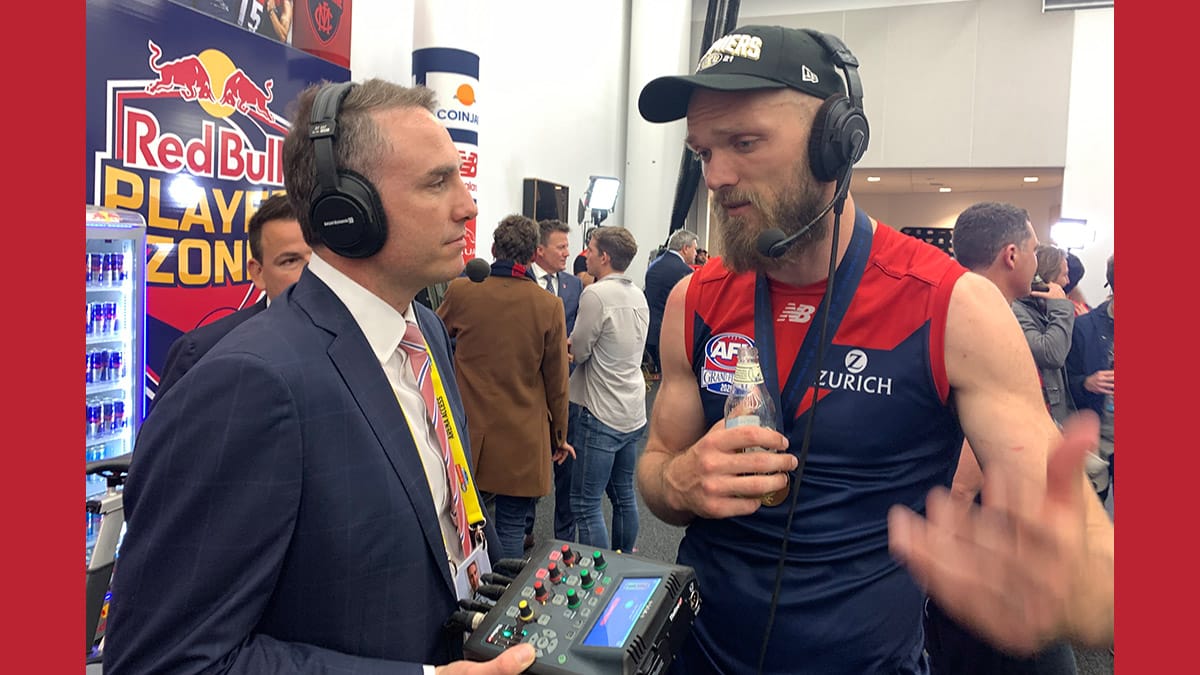PERTH, Australia — As a studio technician for ARN, I look after studios and technology for 96FM and 6PR. For remote outside broadcast applications, we generally manage the coverage of sports from stadia around Perth, live reporting of breaking news and “socially-distanced” shows for our announcers. Our team also looks after onsite news reporting, sideline updates for most sports and outside broadcasts for on-air shows.
Recently, Perth was the host city for the Australian Football League Grand Final at Optus Stadium. This broadcast required multiple setups for local and interstate broadcast teams. It was the culmination of a season that has been steeped in tradition for over 100 years. To be first with interviews and capturing the big day was crucial to our successful broadcast coverage.
We have three Tieline ViA units in Perth, and each uses a dedicated Telstra LANES SIM card. This delivers priority packets over cellular infrastructure. The analogy I use to explain it to staff is that it’s like having an eight-lane freeway at morning peak with seven lanes of bumper-to-bumper traffic, but we get a dedicated lane cleared just for us.
We use Netgear Nighthawk routers with a LANES SIM card. We can connect using Wi-Fi, but prefer to tether using a short LAN cable. The battery life in the ViA codec is awesome. We can confidently wander from the sideline, into change rooms and then a press conference. We are only at the mercy of concrete walls and cell tower coverage.
Matchday Broadcasting
National interest in this event is immense. Both competing teams — the Western Bulldogs and Melbourne — are based in Melbourne. So, anticipation was at fever pitch in that city, with Melbourne also chasing their first premiership in 57 years.
For our 3AW station in Melbourne, we had a Tieline ViA setup in a broadcast box, allowing us to transmit ground sound effects mics and the stadium PA. This provided the remote 3AW Melbourne call team with the atmospherics of being there while they called the game off syndicated vision.
For our local Perth station 6PR, we had our roving reporter use another ViA codec around the stadium to pick up interesting conversations and interviews for our weekend show before crossing to the onsite sports team for the call of the game.
At the completion of the game, we went down to the sideline for trophy and medal presentations and interviews. Our best “get” for the day was hearing former St Kilda player Brett Bowey being interviewed on the phone, so we then grabbed his 19-year-old son Jake who plays for the Melbourne Demons and just won the premiership with Melbourne, and put a headset on him. “I can hear my old man,” he said. After winning the final, the first conversation between a dad and his son wasn’t with SMS, or in the change room later. No, it was our announcer Tim Lane telling Brett and our Melbourne listeners they have his son Jake “on the line.” There were tears. Jake asked his dad, “how many you had?” It was a bit emotional, we got to hear their “we did it” chat about breaking a 57-year premiership drought for the Melbourne football club. The portable ViA codec technology allowed us to get that interview and a little piece of history.
Technical Setup
A lot of our connections these days are ultra-fast. This allows us to trim our latency down to 80–100 ms. Telstra LANES has a significant cost, but when we are on-air 24/7, breaking news and making content, we need to know we can connect reliably. Even when connecting from a full stadium to 3AW in Melbourne, which is about 3,400 km from Perth, we could still reliably get player interviews on the air.
The 6PR sports team at the stadium dial into one of our Merlin codecs at the local studio, and the 6PR ViA codec then dials into another Merlin. These are mixed at the studio. Latency is no issue, and the one-to-one conversations are tight.
Codec Performance
The Tieline ViA has everything that we need for all broadcast situations. At the grand final, the battery ran seamlessly for many hours and our 6PR sideline reporter was reporting from 9 a.m. to 10 p.m. These units are robust, and I’ve never had an issue with our codec sound. Plus, 48 kbps and 100 ms latency works well for us.
From a three-person sports call to long battery life, and an easy web control GUI, the ViA fits perfectly for the needs of news/talk/sport stations. We rely heavily on the battery, and it’s critical to getting where we need to be. Without a battery to self-power, we couldn’t cover bushfire updates, report from the sideline of major sporting events or take it interstate and still appear like we are in our local studios.
The journos love the portability, which allows us to set up exactly where our clients want. This may be an event, press conference or an announcer’s home. This functionality makes our technical setup easier and delivers cost savings.
Our needs with the ViA are simple, and once set up it is usually set and forget. We try to make it easy for the multiple staff that access these units. If they have an issue, they can call our support techs. Producers use the Quick Connect Toolbox software to dial saved connections, whereas the more advanced Toolbox software is used by techs for configuration, saving settings and checking remotely located codecs.
Gone are the days of booking an ISDN line and finding out onsite that the connection is over on the other side of where it was supposed to be. The simplicity that a portable codec provides is immense. We don’t have to rely on old copper phone circuits anymore; we can “walk in working.”
The author is a studio technician at ARN Perth in Western Australia.

